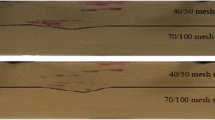Abstract
Nonequilibrium air–water mass transfer experiments using a laboratory‐scale single‐air channel setup were conducted to investigate the influence of porous media and air velocity on the fate of nonaqueous phase liquids (NAPLs) under air sparging conditions. Benzene was used as a NAPL while silica sand 30/50 (dp50=0.305 mm, uniformity coefficient, UC = 1.41) and silica sand 70/100 (dp50=0.168 mm, UC = 1.64) were used as porous media. Air velocities ranged from 0 to 1.4 cm/s. Mass transfer coefficients for the dissolution of NAPLs were estimated by numerical methods using a two‐dimensional dissolution–diffusion–volatilization model. The study showed that the presence of advective airflow in air channels controlled the spreading of the dissolved phase but the overall removal efficiency was independent of airflow rate. Removal efficiencies and dissolution rates of the NAPL were found to be strongly affected by the mean particle size of the porous media during air sparging. More than 50% reduction in the removal rate of benzene was found when silica sand 70/100 was used instead of silica sand 30/50. Mass transfer coefficients for the dissolution of benzene NAPL were estimated to be 0.0041 cm/min for silica sand 70/100 and 0.227 cm/min for silica sand 30/50. Increasing the air velocity from 0.6 to 1.4 cm/s for silica sand 30/50 did not result in a higher removal rate. Quantitative estimation of the dissolution rates of benzene NAPL indicated that the dissolution rates (between 0.227 and 0.265 cm/min) were similar in magnitude for the same porous media but different air flow rates. Based on the visualization study, air sparging may be used to control the spreading of the dissolved phase even when the glob of NAPL is several centimeters away from the air–water interface of the air channels.
Similar content being viewed by others
References
Ardito, C. P. and Billings, J. F.: 1990, Alternative remeidation strategies: the subsurface volatilization and ventilization system, In: Proc. Petroleum Hydrocarbons and Organic Chemicals in Ground Water Conference: Prevention, Detection and Restoration, National Water Well Association, Dublin, OH, pp. 281–296.
Baehr, A. L., Hoag, G. E. and Marley, M. C.: 1989, Removing volatile contaminants from unsaturated zone by inducing advective air phase transport, J. Contam. Hydrol. 4, 1–26.
Baker, R. S.: 1997, Evaluation of saturated zone airflow during in situ air sparging, In: Proc. Fourth International In Situ and On-Site Bioremediation Symposium, New Orleans, LA, April 28-May 1, Vol. 1, pp. 235–240.
Braida, W. J. and Ong, S. K.: 1998a, Air sparging: prediction of air-water mass transfer coefficients, In: Proc. 1998 ASCE National Conference on Environmental Engineering, June 7-10, Chicago, IL.
Braida, W. J. and Ong, S. K.: 1998b, Air sparging: air-water mass transfer coefficients, Water Resour. Res. 34(12), 3245–3253.
Chao, K. P., Ong, S. K. and Protopapas, A.: 1998, Water-to-air mass transfer of VOCs: Laboratoryscale air sparging systems, ASCE J. Environ. Engng 124(11), 1054–1060.
IBM: 1972, System/360 Continuous System Modeling Program user's manual, Program Number 360A-CX, 5th edn, IBM, Technical Pub. Dept., White Plains, New York.
Ji, W., Dahmani, A. Ahlfeld, D. P., Lin, J.D. and Hill, E.: 1993, Laboratory study of air sparging: air flow visualization, Groundwater Monitoring and Remediation 13(4), 115–126.
Johnson, P. C., Das, A., Johnson, R. L., Leeson, A., McWhorter, D. and Hinchee, R.: 1997, Effects of IAS process changes on the removal of immiscible-phase hydrocarbons, In: Proc. Fourth International In Situ and On-Site Bioremediation Symposium, New Orleans, LA, April 28-May 1, Vol. 1, pp. 135–140.
Johnson, R. L., Johnson, P. C., McWhorter, D. B., Hinchee, R. and Goodman, I.: 1995, An overview of in situ air sparging, Groundwater Monitoring and Remediation 13(4), 127–135.
Marley, M. C. and Bruell, C. J.: 1995, In situ air sparging: evaluation of petroleum industry sites and considerations for applicability, design, and operations, API Publication 4609, American Petroleum Institute, Washington, DC.
McCray, J. E. and Falta, R.W.:1997, Numerical simulation of air sparging for remediation of NAPL contamination, Ground Water 35(1), 99–110.
Miller, C. T., Poirier-McNeil, M. M. and Mayer, A. S.: 1990, Dissolution of trapped nonaqueous phase liquids: mass transfer characteristics, Water Resour. Res. 26(11), 2783–2796.
Nelson, D.W. and Sommers, L. E.: 1982, Total carbon, organic carbon, and organic matter, In: A. L. Page (ed.), Methods of Soil Analysis, Part 2: Chemical and Microbiological Properties, 2nd edn, American Society of Agronomy, Soil Science Society of America, Madison, WI, pp. 570–571.
Powers, S. E., Abriola, L. M. and Weber, W. J. Jr.: 1992, An experimental investigation of nonaqueous phase liquid dissolution in saturated subsurface systems: steady state mass transfer rates, Water Resour. Res. 28(10), 2691–2705.
Powers, S. E., Abriola, L. M. and Weber, W. J. Jr.: 1994, An experimental investigation of nonaqueous phase liquid dissolution in saturated subsurface systems: transient mass transfer rates, Water Resour. Res. 30(2), 321–332.
Reddy, K. R., Kosgi, S. and Zhou, J.: 1995, A review of in-situ air sparging for the remediation of VOC-contaminated saturated soil and groundwater, Hazardous Waste & Hazardous Materials 12(2), 97–117.
Reddy, K. R. and Adams, J. A.: 1998, System effects on benzene removal from saturated soils and groundwater using air sparging, ASCE J. Environ. Engng 124(3), 288–299.
Szatkowski, A., Imhoff, P. T. and Miller, C. T.: 1995, Development of a correlation for aqueous-vapor phase mass transfer in porous media, J. Contam. Hydrol. 18, 85–106.
Author information
Authors and Affiliations
Rights and permissions
About this article
Cite this article
Braida, W., Ong, S.K. Influence of Porous Media and Airflow Rate on the Fate of NAPLs Under Air Sparging. Transport in Porous Media 38, 29–42 (2000). https://doi.org/10.1023/A:1006603031438
Issue Date:
DOI: https://doi.org/10.1023/A:1006603031438




